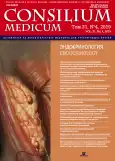Субклинический гипотиреоз и эссенциальная артериальная гипертония: особенности суточной динамики артериальной жесткости у коморбидных больных
- Авторы: Андреева Л.А.1,2, Панченкова Л.А.1, Трошина Е.А.3, Хамидова Х.А.1, Гагиева А.М.2
-
Учреждения:
- ФГБОУ ВО «МГМСУ им. А.И. Евдокимова»
- ФГБУ «Поликлиника №1» Управления делами Президента РФ
- ФГБУ «НМИЦ эндокринологии»
- Выпуск: Том 21, № 4 (2019)
- Страницы: 21-25
- Раздел: Статьи
- URL: https://journals.rcsi.science/2075-1753/article/view/96804
- DOI: https://doi.org/10.26442/20751753.2019.4.190362
- ID: 96804
Цитировать
Полный текст
Аннотация
Полный текст
Открыть статью на сайте журналаОб авторах
Ляйсан Альбертовна Андреева
ФГБОУ ВО «МГМСУ им. А.И. Евдокимова»; ФГБУ «Поликлиника №1» Управления делами Президента РФ
Email: arfelia_marnessa@mail.ru
аспирант каф. госпитальной терапии №1, участковый терапевт Moscow, Russia
Людмила Александровна Панченкова
ФГБОУ ВО «МГМСУ им. А.И. Евдокимова»
Email: lapanchenkova@mail.ru
д-р мед. наук, проф. каф. госпитальной терапии №1 Moscow, Russia
Екатерина Анатольевна Трошина
ФГБУ «НМИЦ эндокринологии»
Email: troshina@inbox.ru
чл.-кор. РАН, д-р мед. наук, проф., рук. отд. терапевтической эндокринологии, зам. дир. по координации эндокринологической службы Moscow, Russia
Хадижат Ахмедовна Хамидова
ФГБОУ ВО «МГМСУ им. А.И. Евдокимова»
Email: k.khamidova@mail.ru
канд. мед. наук, ассистент каф. госпитальной терапии №1 Moscow, Russia
Аида Маирбековна Гагиева
ФГБУ «Поликлиника №1» Управления делами Президента РФ
Email: aida133@mail.ru
врач-терапевт, врач-гастроэнтеролог Moscow, Russia
Список литературы
- Бойцов С.А., Баланова Ю.А., Шальнова С.А. Артериальная гипертония среди лиц 25-64 лет: распространенность, осведомленность, лечение и контроль. По материалам исследования ЭССЕ-РФ. Кардиоваск. терапия и профилактика. 2014; 4: 4-14.
- Nilsson P.M, Boutouyrie P, Laurent S. Vascular aging: a tale of EVA and ADAM in cardiovascular risk assessment and prevention. Hypertension 2009; 54: 3-10.
- Арутюнов А.Г., Ноздрин А.В., Шавгулидзе К.Б. и др. Различия паспортного и биологического (фактического) возраста в популяции российских пациентов, страдающих артериальной гипертензией (анализ регистра «ГИПЕРИОН»). Терапевтический архив. 2018; 4: 21-8.
- Андреева Л.А., Панченкова Л.А., Хамидова Х.А. и др. Артериальная жесткость, центральная гемодинамика у пациентов с гипертонической болезнью, ассоциированной с коморбидной патологией. III сьезд Уральского федерального округа. Екатеринбург, 2016; с. 42-3.
- Кобалава Ж.Д., Котовская Ю.В. Артериальная гипертония в XXI веке: достижения, проблемы, перспективы. 2-е изд., перераб. и доп. М.: Бионика Медиа, 2015.
- Тарловская Е.И. Коморбидность и полиморбидность - современная трактовка и насущные задачи, стоящие перед терапевтическим сообществом. Кардиология. 2018; 58 (9S): 29-38.
- Эндокринология: национальное руководство. Под ред. И.И.Дедова, Г.А.Мельниченко. 2-е изд., перераб. и доп. М.: ГЭОТАР-Медиа, 2016.
- Бланкова, З.Н., Агеев Ф.Т., Середенина Е.М. Гипотиреоз и сердечно-сосудистые заболевания. РМЖ. 2014; 13: 980.
- Iwen K.A, Schröder E, Brabant G. Thyroid Hormones and the Metabolic Syndrome. Eur Thyroid J 2013; 2 (2): 83-92.
- Zayed E.A, Ainshoka A.A, Elshazly K.A et al. Improvement of insulin resistance via increase of GLUT4 and PPARg in metabolic syndrome-induced rats treated with omega-3 fatty acid or l-carnitine. J Biochem Mol Toxicol 2018; 26: e22218.
- Бобрик М.И. Взаимное влияние тиреоидного и углеводного обмена. Парадигмы и парадоксы. Междунар. эндокринологич. журн. 2015; 3 (67): 127-32.
- Tudoran M, Tudoran C. Particularities of endothelial dysfunction in hypothyroid patients. Kardiol Pol 2015; 73 (5): 337-43.
- Некрасова Т.А., Стронгин Л.Г., Леденцова О.В. и др. Взаимосвязь между уровнем ТТГ и некоторыми факторами сердечно-сосудистого риска при аутоиммунном тиреоидите и субклиническом гипотиреозе. Клин. и эксперимент. тиреоидология. 2014; 10 (2): 16-21.
- Le T.N, Celi F.S, Wickham E.P. Thyrotropin Levels Are Associated with Cardiometabolic Risk Factors in Euthyroid Adolescents. Thyroid 2016; 26 (10): 1441-9.
- Волкова А.Р., Красильникова Е.И., Дора С.В. и др. Тиреоидный статус и выраженность коронарного атеросклероза у больных ишемической болезнью сердца. Вестн. Рос. военно-медицинской академии. 2014; 2 (46): 32-5.
- Российское медицинское общество по артериальной гипертонии (РМОАГ), Всероссийское научное общество кардиологов (ВНОК). Диагностика и лечение артериальной гипертензии. Российские рекомендации (третий пересмотр). Кардиоваск. терапия и профилактика. 2010; 6 (Прил. 2).
- Mancia G, Fagard R, Narkiewicz K et al. 2013 European Society of Hypertension-European of Cardiology guidelines for the management of arterial hypertension. J Hypertens 2013; 31 (7): 1281-357.
- Jin Tan, Yinghua Pei, Qi Hua et al. Aortic pulse wave Velocity is associated with measures of subclinical target organ damage in patients with mild hypertension. Cell Biochem Biophys 2014; 70: 167.
- Панченкова Л.А., Хамидова Х.А., Шелковникова М.О. и др. Суточное мониторирование артериальной ригидности у коморбидных больных с сердечно-сосудистой патологией. Казанский мед. журн. 2016; 97 (1): 5-12.
- Андреева Л.А. Связь индекса «Pulse Time Index of Norm» с массой миокарда левого желудочка у больных с артериальной гипертонией в составе метаболического синдрома и гипотиреозом. XXXIХ Итоговая научная конференция молодых ученых 3-4 апреля 2017 г. на базе МГМСУ им А.И.Евдокимова; с. 181-2.
- Posokhov I.N, Kulikova N.N, Starchenkova I.V et al. The "Pulse Time Index of Norm" highly correlates with the left ventricular mass index in patients with arterial hypertension. Vascular Health Risk Management 2014; 10: 139-44.
- Чазова И.Е., Ощепкова Е.В., Рогоза А.Н. и др. Диагностика и лечение артериальной гипертонии. Клин. рекомендации. 2013.
- Biondi B, Bartalena L, Cooper D.S et al. The 2015 European Thyroid Association Guidelines on Diagnosis and Treatment of Endogenous Subclinical Hyperthyroidism. Eur Thyroid J 2015; 4 (3): 149-63
Дополнительные файлы






